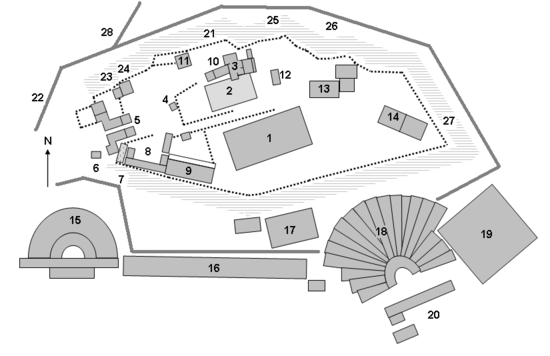Aglaureion
The Aglaureion ( Greek Ἀγλαυρεῖον ) or Agrauleion (also Aglaurion or Agraulion) was a sanctuary of Aglauros , the daughter of the mythical king Kekrops I of Attica . The sanctuary was on the Peripatos , a path below the Acropolis of Athens .
Mycenaean spring
For a long time it was assumed that a spring from Mycenaean times , which is located in a cave and was connected to the Acropolis by a secret entrance, was identical to the sanctuary of Aglauros. This was based mainly on the tradition of Pausanias . On his tour of Athens , he first describes the Theseion on the agora . Then he names the sanctuary of the Dioscuri , the Anakion , which is said to have been located directly below the Aglaureion, but whose location is not known. Here Aglauros is said to have thrown himself to his death and the Persians are said to have been here, on the steepest ascent, 480 BC. Have climbed and conquered the Acropolis. Then Pausanias continues his way to the Prytaneion and the Ptolemaion.
Inscription of the Aglauros priestess
In 1983 the archaeologist Georgios Dontas discovered an inscription in a cave east of the Acropolis. It is in the tenure of the Archon Eponymos Polyeuktus, in the year 249/48 BC. Chr. And reports of the inauguration of the priestess Timocrite, daughter of Polynikos of Aphidnai . The inscription also states that the associated stele should be placed in the Aglaureion. This inscription is an indication that the eastern cave was consecrated to the Aglauros. Herodotus' statements also seem to confirm this, according to which the Persians climbed the rocks at the front, opposite the entrance to the Acropolis, near the temple of Aglauros. The fact that he describes the east side of the Acropolis Mountain as the front suggests that the agora with the Prytaneion was in the east. Even Ulrich Köhler had indicated in 1871 that the Tholos was north called the Acropolis not as prytaneum but Prytanikon. If the discovery of the inscription suggests the location of the sanctuary, it reignited the discussion about the location of the agora.
function
Once a year the Athenians celebrated the festival Aglauria (also: Agraulia) in honor of the Aglauros. It is not known when this holiday was and how it was celebrated. Possibly this was the day on which the youths who had come of age, the Ephebe , were sworn in. It is said that in the Aglaureion they had to swear to defend their homeland and to respect the laws.
Polyainos reports that Peisistratos once planned to disarm the citizens. So he had everyone gathered with arms at the Anakion, the sanctuary of the Dioscuri. Now he spoke to them softly. While the Athenians listened intently, Peisistratos' followers took the weapons and carried them into the Aglaureion. Only now did the citizens realize that they had been tricked.
Individual evidence
- ^ Pausanias, Travels in Greece , 1, 18, 2.
- ^ Searchable Greek Inscriptions SEG 33: 115
- Jump up ↑ Herodotus, Historien , 8, 53.
- ↑ Ulrich Köhler, Studies on Attic Psephisms , in: Hermes 5 (1871), pp. 328–351
- ↑ Georgios Dontas, The true Aglaurion , in: Hesperia 52 (1983), pp. 48-63
- ↑ John K. Papadopoulos, Ceramicus redivivus: The early Iron Age potters' field in the area of the classical Athenian Agora , Athens, 2003. pp. 282-285.
- ^ Iulius Pollux , Onomasticon , 8, 105-106.
- ↑ John Stobaios , Sermones , 41, 141.
- ^ Polyainos , Strategika , 1, 21, 2.
Web links
Coordinates: 37 ° 58 ′ 18 ″ N , 23 ° 43 ′ 43 ″ E

